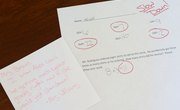Many times, life skill tasks that seem obvious to people without autism seem complicated and overwhelming to people with autism. Those with autism must be taught skills such as managing money, basic cooking, laundry and housekeeping before they are ready to venture out and be as independent as possible. Hopefully, the parents of children with autism will begin teaching these skills as early as possible. The following techniques can be applied to learning any skill.
Forward Chaining
Break the task down into small, logical steps. For example, if teaching how to do laundry, you would first break the task into WASH, DRY, FOLD, PUT AWAY. Then you would break those steps down further. WASH becomes SORT CLOTHES, SET WASH CYCLE, TURN WASHER ON, ADD SOAP, ADD CLOTHES, CLOSE LID. These steps can be broken down even further. SORT CLOTHES becomes: separate WHITES, LIGHTS, DARKSBreak down the task into as many small steps as possible.
Teach just the first step of the task. When you do laundry, ask your teen to help you with the step they are to learn. Explain what he needs to do, and model if necessary. Provide help where needed and don't let your teen become frustrated.
When your teen has successfully completed the step, let her know she has done a good job by whatever type of praise she responds to. Then, complete the rest of the tasks yourself. Talk about what you are doing as you do it.
Allow your teen to complete the step he is working on each time you do the task he is learning until he has mastered the step and can complete it independently.
Repeat Steps 2 through 4 with the second step in the process you are teaching. Have your teen complete only the step she is working on.
When your teen has mastered the second step of the task, ask him to complete the first and second steps together.
Repeat Steps 2 through 6 until the task is mastered.
Backward Chaining
Break the task down just as you did in Step 1 of Section 1, only work backwards. Steps for doing laundry when backwards chaining would be PUT CLOTHES AWAY, FOLD CLOTHES, REMOVE FROM DRYER, PLACE IN DRYER, REMOVE FROM WASHER, CLOSE LID, ADD CLOTHES, ADD SOAP, TURN WASHER ON, SET WASH CYCLE, SORT CLOTHES.
Start with the last step of the task, in this case, PUT CLOTHES AWAY. Teach your teenager that step first. Have him complete the step each time you do laundry until your teen masters this step. If your teen has motor difficulties, you will need to help him find a method that works for him. Maybe he can hang his clothes, but using drawers is impossible. Or perhaps open shelves would work better for your child. Don't be afraid to adapt the environment to meet your child's needs.
Teach FOLD CLOTHES. If your teen has physical difficulties, you may need to adapt her method of folding clothes, or let her hang everything up. Use whatever method gives your teen the most amount of independence.
Ask your child to complete the task he is learning and the next one each time you do the job. Continue until he masters the task.
Continue moving through the steps as your teen masters them. If she hits a difficult point, step back and reevaluate the task. Ask yourself if your teen needs adaptations made to the task, or if she just needs more time to learn it. Go back to the last task she were successful in mastering and just do those tasks for a few days to help rebuild confidence.
Tip
Backwards chaining works like forward chaining, but some people respond to it better.
Tip
Allow your teen as much independence as possible, even if that means adapting the task or the tools used to his physical and mental abilities.
Tip
Consider using a washing glove instead of a sponge to wipe down counters. Try pump dish and laundry soap. Consider open shelves instead of drawers. Perhaps try a robot that sweeps and mops floors instead of a traditional broom and mop.
Warning
Take care to avoid frustration as much as possible. Frustration can cause negative associations with the learned task. If you can foster more positive associations, your teen is more likely to learn and use the task.
Related Articles
Tips
- Backwards chaining works like forward chaining, but some people respond to it better.
- Allow your teen as much independence as possible, even if that means adapting the task or the tools used to his physical and mental abilities.
- Consider using a washing glove instead of a sponge to wipe down counters. Try pump dish and laundry soap. Consider open shelves instead of drawers. Perhaps try a robot that sweeps and mops floors instead of a traditional broom and mop.
Warnings
- Take care to avoid frustration as much as possible. Frustration can cause negative associations with the learned task. If you can foster more positive associations, your teen is more likely to learn and use the task.










